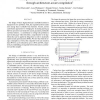Free Online Productivity Tools
i2Speak
i2Symbol
i2OCR
iTex2Img
iWeb2Print
iWeb2Shot
i2Type
iPdf2Split
iPdf2Merge
i2Bopomofo
i2Arabic
i2Style
i2Image
i2PDF
iLatex2Rtf
Sci2ools
ASPDAC
2004
ACM
2004
ACM
Fast, predictable and low energy memory references through architecture-aware compilation
The design of future high-performance embedded systems is hampered by two problems: First, the required hardware needs more energy than is available from batteries. Second, current cache-based approaches for bridging the increasing speed gap between processors and memories cannot guarantee predictable real-time behavior. A contribution to solving both problems is made in this paper which describes a comprehensive set of algorithms that can be applied at design time in order to maximally exploit scratch pad memories (SPMs). We show that both the energy consumption as well as the computed worst case execution time (WCET) can be reduced by up to to 80% and 48%, respectively, by establishing a strong link between the memory architecture and the compiler.
| Added | 30 Jun 2010 |
| Updated | 30 Jun 2010 |
| Type | Conference |
| Year | 2004 |
| Where | ASPDAC |
| Authors | Peter Marwedel, Lars Wehmeyer, Manish Verma, Stefan Steinke, Urs Helmig |
Comments (0)

